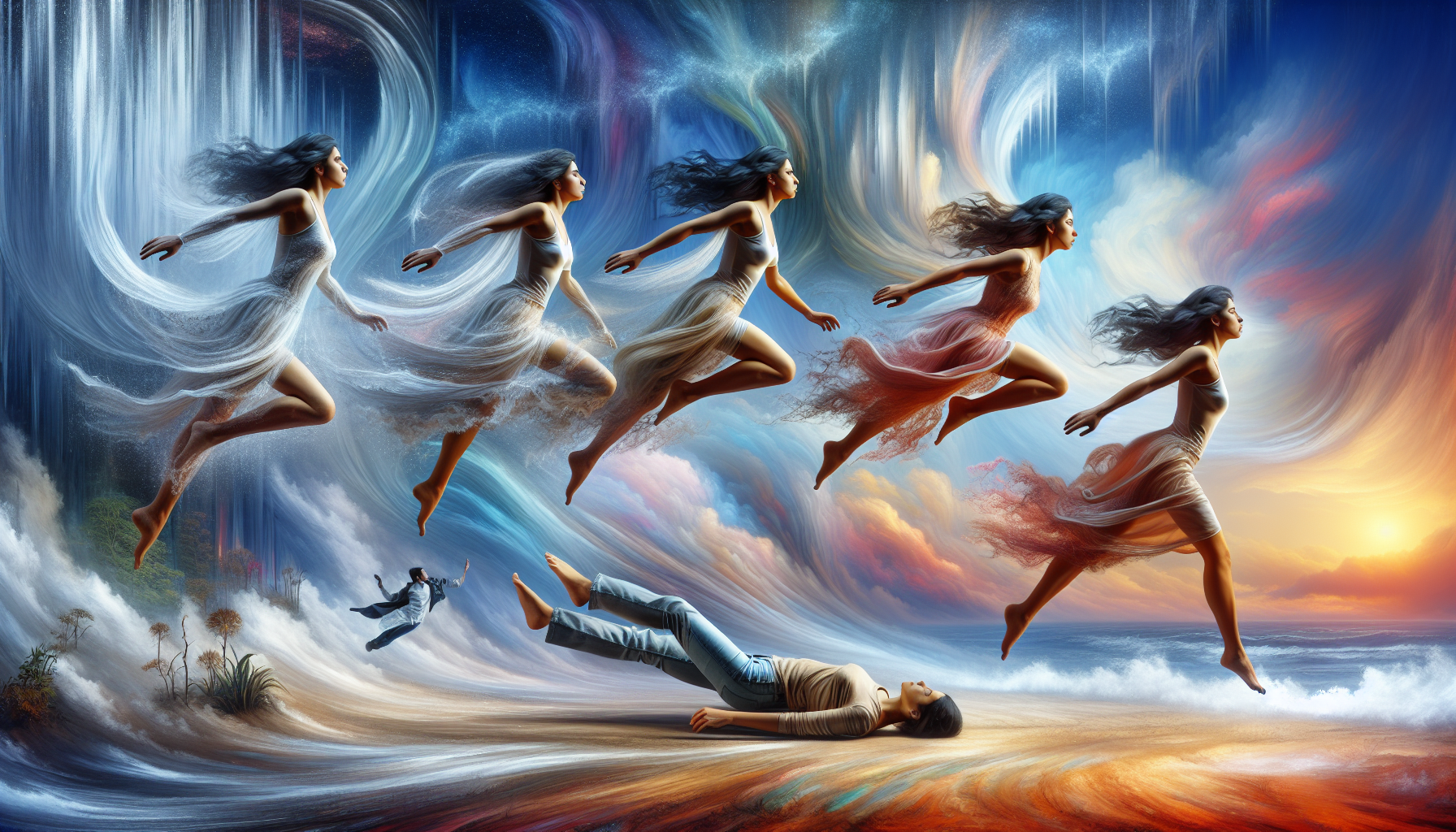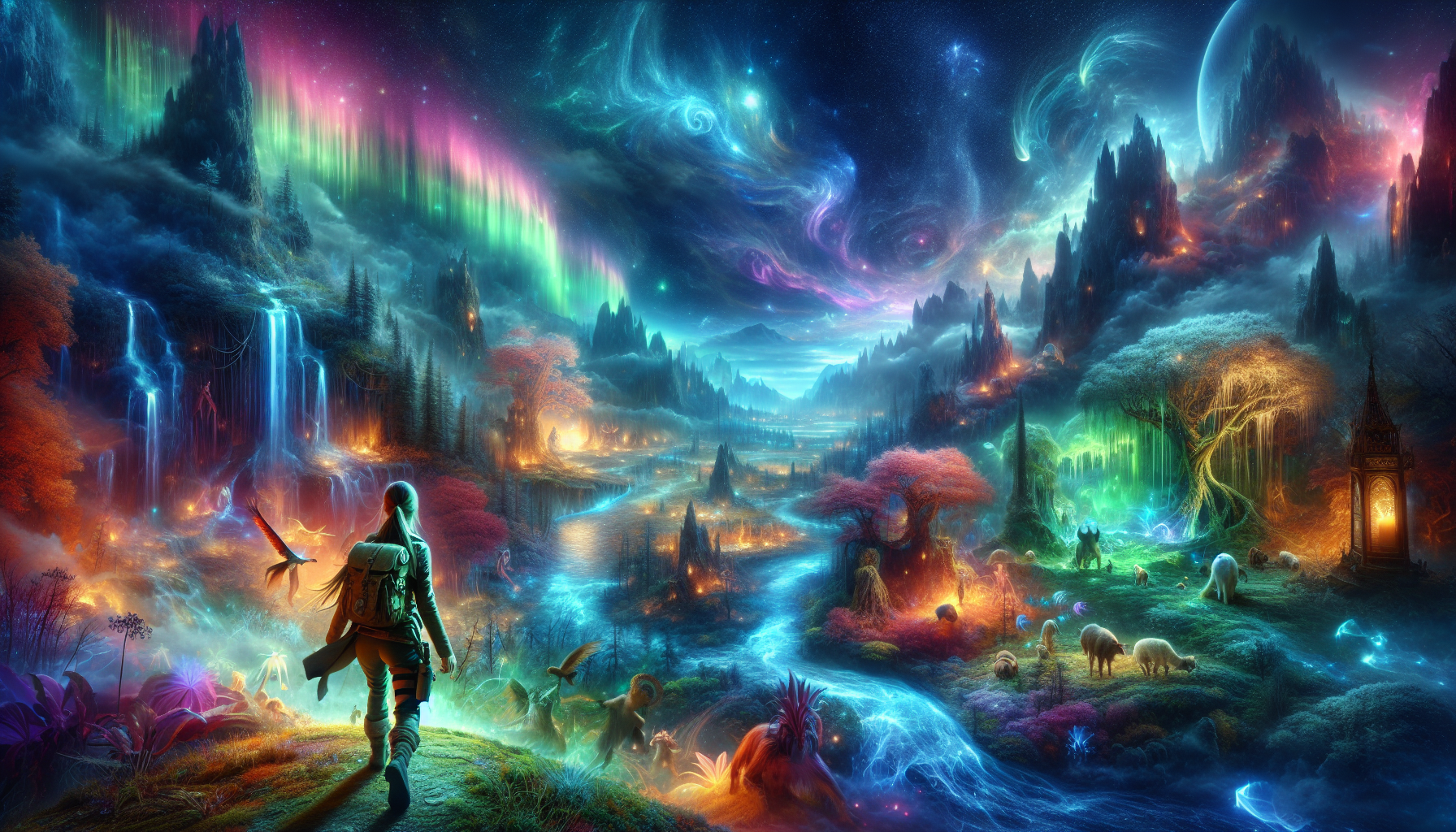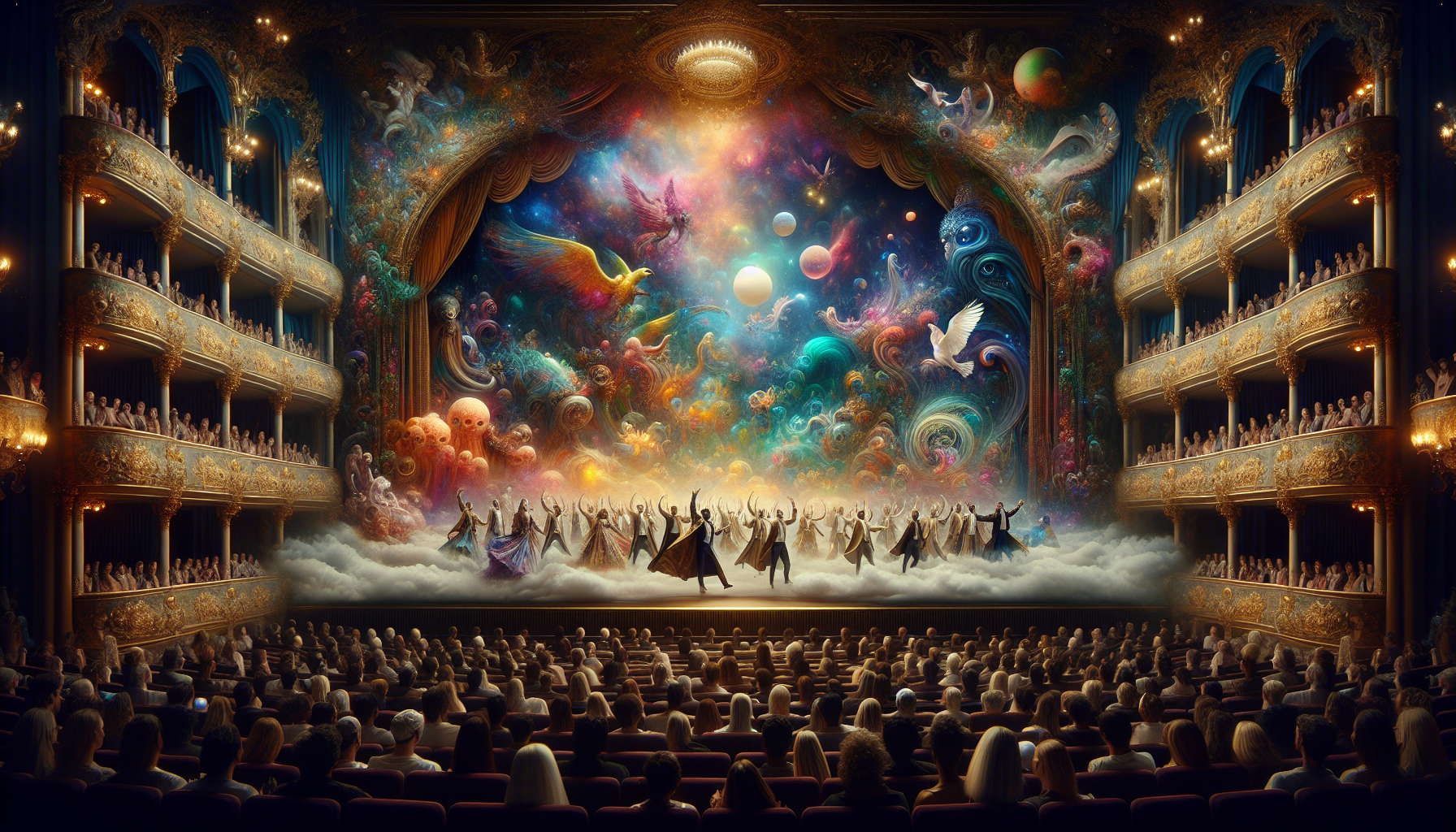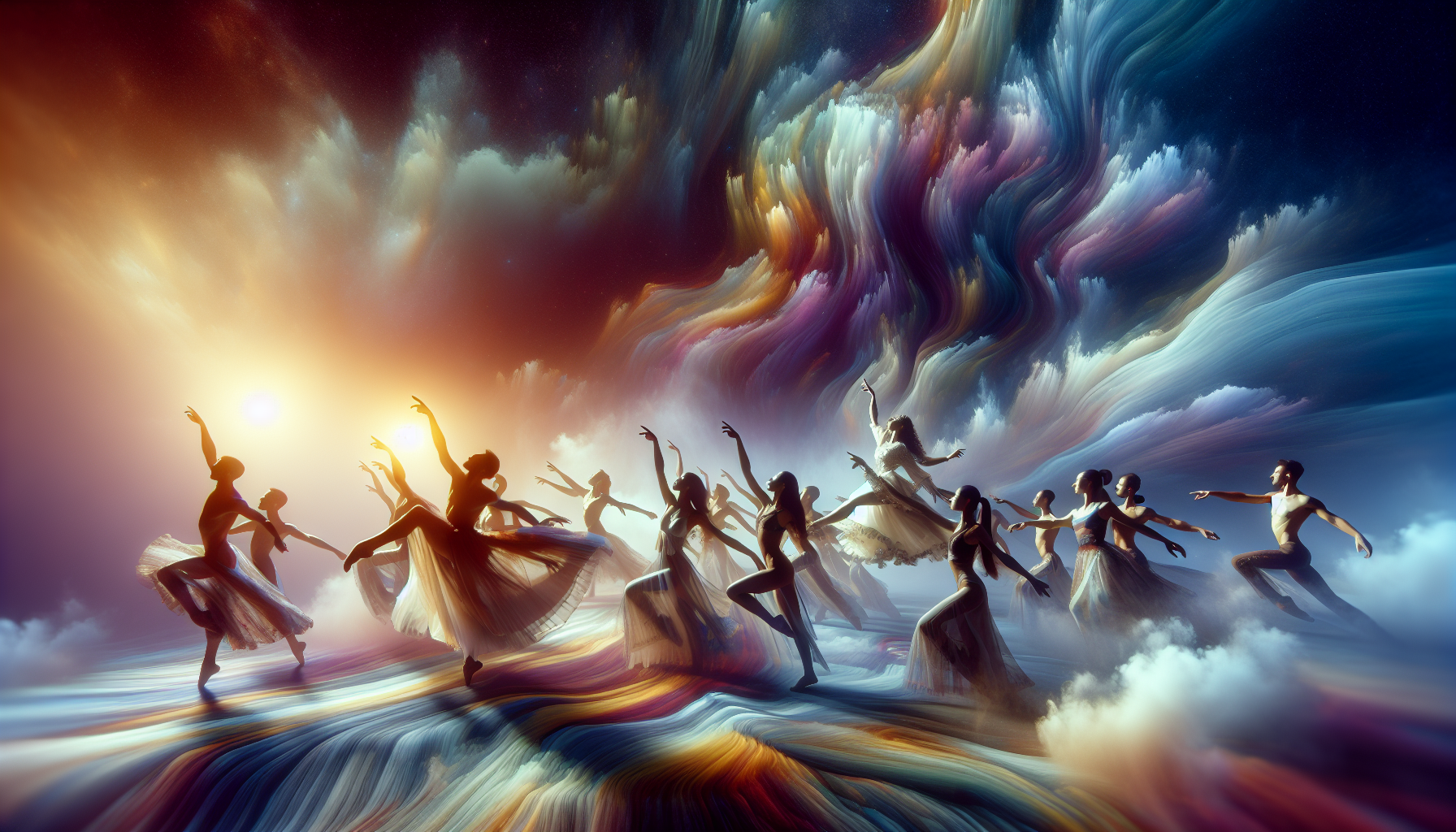Dreams have long been a source of fascination, providing a mysterious window into the subconscious mind, a place where reality bends and the impossible becomes possible. Within these nightly narratives, we often find ourselves in motion, experiencing the exhilarating sensations of falling, flying, or running. These themes—falling, flying, and running—are among the most common dream motifs and hold a rich tapestry of meanings that can illuminate our waking lives. Whether you’re plummeting from a great height, soaring through the skies, or sprinting towards an unknown destination, these dream scenarios can evoke powerful emotions and insights. But what do these movements truly signify in the realm of dreams, and why do they resonate so deeply with our human experience? 🌙✨
As we embark on this exploration of “Emotions in Motion,” we’ll delve into the psychological and symbolic interpretations of these dynamic dream themes. Each of these movements—falling, flying, and running—carries its own set of emotions and potential meanings, often reflecting our deepest fears, desires, and challenges. The sensation of falling, for instance, can be linked to feelings of insecurity or loss of control, echoing moments in our lives where we may feel overwhelmed or vulnerable. Flying, on the other hand, often embodies a sense of liberation and empowerment, allowing us to break free from the constraints of daily life and explore new heights of possibility. And then there’s running, which can represent everything from the pursuit of goals to the instinctual need to escape danger. In this article, we will unpack these themes, drawing on insights from psychology, mythology, and cultural studies to offer a comprehensive understanding of what these movements in dreams might reveal about our inner worlds.
Join us as we traverse the landscape of dreams, where the act of falling might just be a prelude to discovering our resilience, where flying becomes a metaphor for unbridled ambition and creativity, and where running transforms into a journey towards self-discovery and fulfillment. We’ll explore how these dream movements not only reflect our subconscious mind but also offer us valuable lessons and perspectives that can enhance our waking lives. Through this journey, we’ll connect the dots between the symbolic language of dreams and the tangible emotions they evoke, providing you with insights and tools to interpret your own nocturnal adventures. So, prepare to dive deep into the mysteries of your dream world, and let’s uncover the emotional currents that propel us through the night. 💤💫
Understanding the Symbolism of Falling in Dreams
Falling is a common theme in dreams, often evoking feelings of vulnerability and loss of control. When someone dreams of falling, it can be interpreted in various ways depending on the context and emotions involved. Falling can symbolize a fear of failure, insecurity, or a loss of stability in one’s waking life. It can also represent a need for grounding or a call to confront deep-seated fears. As with many dream symbols, the meaning of falling is subjective and can vary greatly from person to person.
In the realm of psychology, falling dreams are often associated with anxiety and stress. These dreams can reflect an inner turmoil or a sense of being overwhelmed by life circumstances. Falling in a dream might suggest that the dreamer feels unsupported or lacks a firm foundation. The sensation of falling can be particularly jarring, often jolting the dreamer awake and leaving a lingering sense of unease.
To further delve into the significance of falling dreams, it’s helpful to consider the context in which they occur. Are you falling from a great height, or is it a short tumble? Are you alone, or are others present? Each element of the dream can provide additional insights into what your subconscious mind might be trying to communicate. The table below offers a comparative analysis of different types of falling dreams and their possible interpretations:
| Type of Falling Dream | Possible Interpretation |
|---|---|
| Falling from a Great Height | Fear of failure or loss of control |
| Tripping or Stumbling | Minor setbacks or mistakes |
| Falling into Water | Emotional overwhelm or unresolved feelings |
| Falling and Landing Safely | Resilience or overcoming obstacles |
For a deeper understanding of falling dreams, watch the insightful video below. It explores various interpretations and offers guidance on how to process these experiences: The Psychology of Falling Dreams – Dreaming Mind Channel. 🎥
The Concept of Flying in Dreams
Flying in dreams is often perceived as a liberating and exhilarating experience. Unlike falling, which can evoke fear, flying is typically associated with freedom, empowerment, and transcendence. When you dream of flying, it can signify a desire to rise above life’s challenges or to break free from constraints. This type of dream is often seen as a positive indication of personal growth and potential.
In psychological terms, flying dreams might reflect an individual’s aspirations or ambitions. They could also indicate a sense of achievement or the overcoming of limitations. The feeling of soaring through the air can be a metaphor for reaching new heights in one’s personal or professional life. Additionally, the level of control one has while flying in the dream can offer insights into their confidence and self-efficacy.
Like falling dreams, the context and emotions experienced during the flight can add depth to its interpretation. Are you flying alone, or are you accompanied by others? Is the flight smooth and effortless, or is it fraught with turbulence? The answers to these questions can help in understanding what the dream might signify. Check out the table below for a comparative overview of flying dreams:
| Type of Flying Dream | Possible Interpretation |
|---|---|
| Effortless Flight | Confidence and self-assurance |
| Struggling to Fly | Challenges in achieving goals |
| Flying with Others | Shared ambitions or goals |
| Flying and Falling | Fear of failure or losing control |
To explore flying dreams further, consider watching the following video that discusses the symbolism and meaning behind these dreams: Understanding Flying Dreams – Dream Analysis Channel. 🌟
Running in Dreams: The Pursuit and the Escape
Running is a dynamic and potent theme in dreams, often linked to the concepts of pursuit and escape. When you dream of running, it could represent a variety of emotional states and psychological needs. Running towards something might suggest ambition and drive, while running away can indicate fear or avoidance. These dreams can reflect how you deal with life’s challenges and obstacles.
Running dreams can also be indicative of stress or anxiety. If you find yourself running away from an unknown threat, it might symbolize a situation in your waking life that you’re trying to avoid. Conversely, running towards a goal can signify determination and focus. Understanding the nuances of running in dreams can provide valuable insights into your subconscious mind and emotional well-being.
The table below highlights different scenarios of running in dreams and their potential meanings:
| Type of Running Dream | Possible Interpretation |
|---|---|
| Running Away | Fear or avoidance of a situation |
| Running Towards a Goal | Ambition and motivation |
| Running in Place | Feeling stuck or unable to progress |
| Running with Ease | Confidence and agility |
For further insights on running dreams and their meanings, be sure to watch this informative video: Decoding Running Dreams – Dream Insights Channel. 🏃♂️
Conclusion
The exploration of dreams through the lenses of falling, flying, and running reveals a fascinating tapestry of human emotions and psychological insights. Throughout this article, we’ve delved into how these motifs not only reflect our subconscious states but also connect to broader themes in our waking lives. Let’s revisit the essential points discussed and underline the significance of this exploration.
Dreams of falling, often associated with feelings of loss of control or fear of failure, serve as powerful metaphors for situations in our waking life where we feel overwhelmed or anxious. These dreams encourage us to confront our fears and reassess areas where we may feel insecure. By understanding these dreams, we can cultivate a sense of empowerment and develop strategies to regain control over the aspects of our lives that feel unstable.
Conversely, dreams of flying typically embody a sense of liberation, ambition, or transcendence. Such dreams often occur when we are experiencing growth or seeking to rise above challenges. They inspire us to pursue our aspirations and remind us of our innate potential to achieve great heights. By tapping into the symbolism of flying dreams, we can motivate ourselves to embrace change and strive towards personal and professional goals.
Running dreams, whether they involve being chased or racing towards something, highlight our responses to pressure, urgency, and sometimes avoidance. These dreams can signal a need to confront issues head-on or the desire to escape from situations that cause stress. Recognizing these patterns enables us to address the root causes of our anxieties and promotes a proactive approach to problem-solving.
The exploration of these dream motifs emphasizes the interconnectedness of our subconscious and conscious minds. By paying attention to the emotional undertones of these dreams, we gain valuable insights into our deepest fears, desires, and motivations. This understanding can be transformative, guiding us to make informed decisions and fostering emotional resilience.
The study of dreams is not merely an academic pursuit; it is a journey towards self-discovery and emotional well-being. As we interpret the symbols and narratives that emerge during sleep, we can harness the power of our dreams to enhance our waking lives. By engaging with the themes of falling, flying, and running, we are reminded of the dynamic nature of our emotions and the potential for growth and healing they hold.
In conclusion, the analysis of dreams featuring falling, flying, and running provides a profound understanding of our inner world. These dream themes act as mirrors, reflecting our deepest fears and aspirations while offering guidance for personal growth. As we explore these dreams, let us remain open to the lessons they impart and the opportunities for transformation they present.
The importance of this exploration cannot be overstated. By acknowledging and interpreting our dreams, we unlock a deeper understanding of ourselves and the world around us. We invite you to reflect on your own dreams and consider how they might be speaking to you. Share your thoughts and experiences with others, as discussing and analyzing dreams can foster community and support.
Feel free to leave a comment below with your thoughts or share this article with friends who might find it insightful. Let’s continue this exploration together, turning our dreams into a source of inspiration and growth. 🌟
For further reading on the science of dreaming, consider exploring resources such as the Sleep Foundation (https://www.sleepfoundation.org/) or Psychology Today (https://www.psychologytoday.com/). These platforms offer a wealth of information on sleep and dream research, contributing to our understanding of these fascinating phenomena.

Gabriel is a visual storyteller and dream archivist whose work explores the fragile boundary between memory and imagination. Through layered visuals and symbolic design, Gabriel captures the fleeting essence of dreams — those strange, beautiful, and sometimes haunting fragments that drift through sleep and linger in waking thought.
His creative journey is rooted in a deep fascination with the subconscious and the imagery it conjures. From half-remembered landscapes to recurring symbols and surreal encounters, each piece Gabriel brings to life becomes a portal into the inner archive — where time distorts, meanings shift, and personal mythology takes form.
With a background in handcrafted artistry and visual composition, Gabriel merges intuition with intention. His work doesn’t merely depict dreams; it preserves them, translating ephemeral moments into tangible expressions that evoke emotion, curiosity, and quiet revelation. Each visual is both a record and an invitation to explore the rich terrain of inner life.
Through illustrated dream journals, symbolic studies, and visual essays, Gabriel invites others to connect with the poetic architecture of their subconscious landscapes. His art becomes a mirror — not only of what we see at night, but of what we carry deep within.
His work is a tribute to:
-
The fragile beauty of forgotten dreams
-
The language of symbols in the subconscious mind
-
The inner worlds we visit but rarely name
Whether you’re a lucid dreamer, a seeker of hidden meanings, or someone fascinated by the mystery of sleep-born stories, Gabriel welcomes you to step into a space where dreams are not lost — they are archived, one vision, one sketch, one silent narrative at a time.





